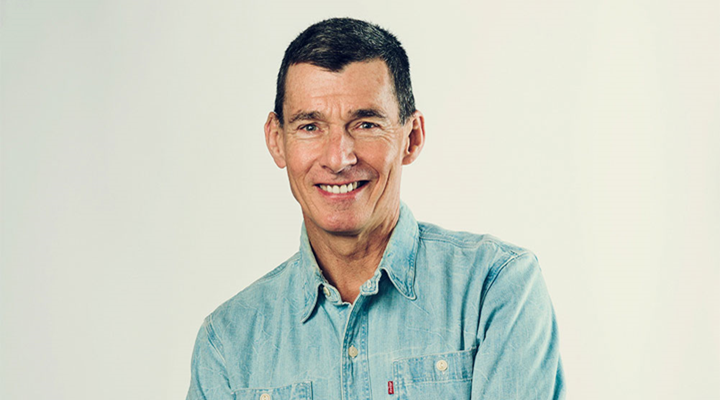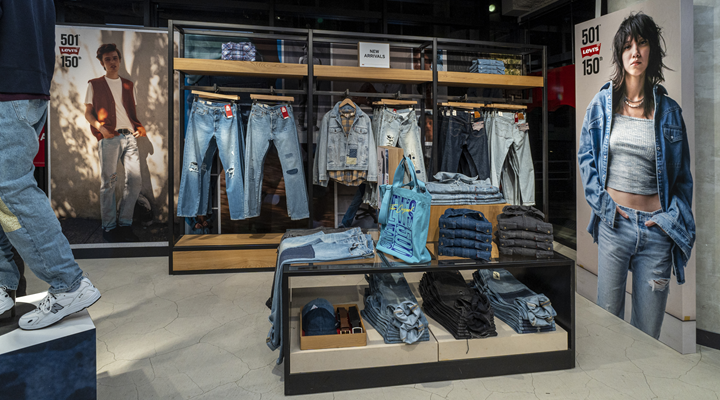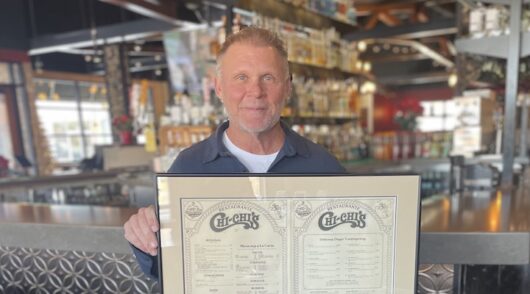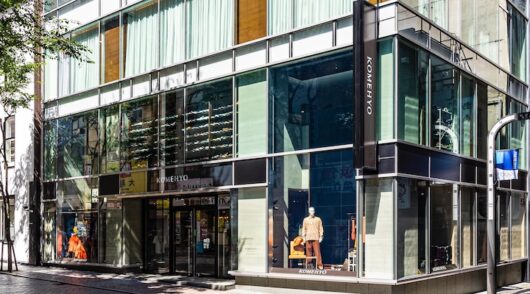“I like to say that everybody’s got a Levi’s story. Everybody.” Chip Bergh is sitting at the head of a small table in a sunny corner of his seventh-floor office at Levi’s Plaza, the corporate headquarters of Levi Strauss & Co, in San Francisco. A model of Levi’s Stadium, the home of the San Francisco 49ers, which Levi’s acquired the naming rights to in 2013, and where Taylor Swift and Beyoncé recently performed on their respective blockbuster tours, rests on a near
a nearby ledge.
On the other side of the room, an open shoebox reveals a pair of super limited edition Levi’s x Crocs All-Terrain Clogs made with deadstock denim upcycled by Japanese designer Proleta Re Art. It is one of just 60 pairs created worldwide.
Bergh, who has served as president and CEO of Levi Strauss & Co since 2011, is reflecting on his legacy as he prepares to hand over the reins of the $6 billion global business to his successor Michelle Gass, the former CEO of American department store chain Kohl’s, who joined Levi’s earlier this year.
His retirement on April 26, 2024 has just been officially confirmed, providing the two leaders with an extended transition period.
“My favorite Levi’s story,” Bergh continues, “is when I graduated from university. I went into the military – I was based in West Germany – and the very first vacation I took was a Eurail trip through the Nordics.”
Bergh wasn’t making much money, so he was staying in youth hostels and campgrounds. And when it came time to wash his clothes, rather than go to a laundromat, he would simply take a shower fully dressed.
“I was in Bergen, Norway – I remember exactly where I was – and I took my wallet out of my pocket, hopped in the shower, washed myself down, rinsed myself off, hung up my clothes and went to bed,” he recalls.
“The next morning I realized I’d left my wallet in the bathroom, so I ran into the bathroom and – you know how the story ends – the wallet was there, the Levi’s were gone. That was the power of the brand when I was 22 years old in 1980.
“I remembered that story when I was being recruited for this job in 2011, and I thought, ‘We’ve got to get it back to what it was like then.’”
From humble beginnings…
Levi’s was founded in 1853 by Levi Strauss, an immigrant from Bavaria who opened a dry goods business in San Francisco at the height of the California Gold Rush.
Initially, the business supplied wholesalers across the American West with ready-made clothing, fabric and other textiles, but in 1872, a tailor named Jacob Davis approached Strauss about patenting a design for denim pants reinforced with copper rivets. The patent was granted, and in 1873, the first pair of Levi’s jeans was born.
Over the years, Levi’s evolved from workwear worn by miners, cowboys and other physical laborers, to a fashion statement embraced by Hollywood stars, musicians, revolutionaries and ordinary people – with shockingly few design changes along the way.
The brand became a symbol of self-expression and was one of the rare labels to achieve global recognition in the pre-internet age.
By the 1990s, however, the business was starting to face increased competition from cheaper brands and lose cachet with younger consumers. When Bergh was appointed CEO in 2011, Levi’s annual sales had been on a mostly downward trajectory for over a decade.
“When I got here, I interviewed the top 60 leaders,” Bergh says. “It was very clear, after even a dozen interviews, that there were some things that were sacred that we had to protect, like our values, the stands that we have taken over the decades. But the other thing that was clear was the company didn’t have a strategy. When I asked people, ‘What are the three things we’re trying to do as a company?’ I got a random answer from everybody.”
Drawing on his nearly 30 years at P&G, the multinational consumer packaged goods firm where he learned the importance of data-driven decision-making, Bergh dissected Levi’s finances to understand what was working, what wasn’t, where the business was growing and profitable, and where it was losing money.
“Our women’s business was underdeveloped, our tops business was underdeveloped [as opposed to bottoms, i.e., jeans], our international business was underdeveloped,” Bergh recalls. “We had some markets like China, which is 20-plus per cent of the world’s population and it was 2 per cent of our business. It was the same thing in India… way underdeveloped.”
Within his first year at Levi’s, Bergh laid out three key objectives: grow the profitable core, expand for more, and become a world-class omnichannel retailer.
“That strategy took us from not delivering results to growing six-plus per cent from 2015 to 2019 when we did the IPO on a CAGR basis. It was pivotal,” he says.
Today, Levi’s generates over 40 per cent of its revenue from DTC sales, and its tops business is worth about $1 billion, up from around $200 million in 2011, according to Bergh, though he still sees room for improvement.
During the company’s Q3 earnings call in October, Gass revealed that India is now the brand’s largest market in Asia, and its sixth largest market globally. As a whole, Asia accounts for nearly 20 per cent of the company’s revenue, up from around 13 per cent when Bergh first started.
“Asia is a huge part of our growth algorithm. Coming out of the pandemic, we’ve been growing pretty consistently by double-digits in Asia, and we’re expecting that going forward,” says Bergh, who describes himself as a “believer” in the importance of the emerging markets.
“When you look at the demographics, and put it all together, there’s a lot of potential there. Let’s go after it.”
To global dominance
As part of the leadership transition, Bergh and Gass have been travelling to Levi’s markets around the world, meeting with store teams and customers. They recently toured Bangkok, Manila and Singapore – their third trip to Asia so far this year – and Gass is still buzzing with excitement as she recalls the visit in a boardroom at the company’s headquarters in September.
“What struck me was the vibrancy, the youthfulness, and all the cultural changes that are happening,” she says about the Southeast Asian market. “It’s fascinating to see how brands are showing up – very fresh, innovative, forward-looking. I think how stores are coming to life, it just feels like an evolved shopping experience.”
Levi’s currently operates more than 1000 retail stores around the world, but it is still looking to expand its physical presence internationally, and there’s no question that the focus is firmly on Asia.
Over the past few years, the company has taken back control of its operations in Singapore and Thailand and invested in its store network throughout Southeast Asia.
In December 2022, Levi’s opened a 3400sqft store at Ion Orchard shopping centre in Singapore. More than twice the size of its previous location – which was operated by a brand partner – and more profitable, the new store stocks Levi’s high-end Made & Crafted range and features a Tailor Shop, where customers can personalize products with patches, embroidery and other add-ons. The brand opened a similar concept store in the Philippines this past July.
“When I see how the Levi’s brand is performing around the world, and if we take Asia in particular, it’s the strongest it’s ever been,” Gass says.
Based on conversations she has had with consumers in this market, Gass believes that the Levi’s brand resonates with Asian consumers on a fundamental level. However, she is acutely aware of the need to adapt the product offering and marketing to suit local tastes.
“You can’t just say, ‘Here’s the Levi’s concept and it’s plug-and-play into any of these cultures and cities,’” she says. “The consumer does want true Levi’s, so you give them authentic Levi’s, but then how you bring it to life can be tailored to the local consumer.”
One example of this is the cool technology denim that Levi’s developed with Asian consumers in mind. The denim is made from a lighter fabric with moisture-wicking and breathable properties, so it’s more comfortable to wear in hot and humid climates like many parts of Asia. Sizing is part of this, too, and Gass notes that each market can choose their assortment based on the fits and sizes that work best for their customers.
Another example is the brand’s partnership with K-pop phenomenon NewJeans. The idea to collaborate with the now-hugely popular girl group was floated by the Levi’s team in Korea last year, before many people had heard of the band. Gass calls it a “happy coincidence” that the name of the group references the company’s most iconic product.
Since the partnership was first announced in March, as part of the year-long, global celebration of the 150th anniversary of the company’s 501 jeans, the five members of NewJeans – Hyein, Hanni, Minji, Haerin and Danielle – have appeared in Levi’s Spring/Summer and Fall/Winter marketing campaigns, and they have worn Levi’s during their performances.
The internal response has been overwhelmingly positive, so it’s safe to say that further initiatives are in the works.
“For Levi’s, aligning with NewJeans speaks to that local relevance, but it’s not just about Korea, or even Asia. They have had an impact globally, and we’ve been able to be part of that,” Gass says.
“From their standpoint, they also benefit by attaching their brand to Levi’s and benefitting from the overall reach we have. I think the best relationships are [ones] where every party is giving something and getting something, and it’s been a fantastic partnership.”
What’s next?
Back in his office in San Francisco, Bergh is recounting the most pivotal decisions he has made during his tenure at Levi’s, and how they helped the brand reclaim its position at the centre of culture and return to profitable growth.
There are many – from acquiring the naming rights to Levi’s Stadium for the not insignificant sum of $220 million over 20 years, to opening the Eureka Innovation Lab, which led to some of the brand’s most impressive product developments, to launching the ‘Batwing’ T-shirt, which supercharged the women’s business, to taking a public stand on gun violence.
But one stands out above the rest.
“I think my biggest legacy at the end of the day is going to be Michelle,” Bergh says. “The team has worked really hard to get the business turned around, and I’ve got so much confidence that she’s going to come in and take the company to the next level.”
This story first appeared in the November 2023 issue of Inside Retail Asia magazine.
The journalist visited the corporate headquarters as a guest of Levi’ Strauss & Co.










